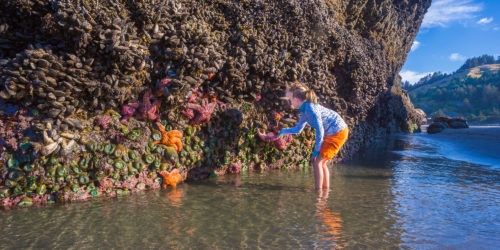Two possible experiences await Winter Whale Watch week sightseers. Either one, says Oregon State Park Ranger Morris Grover, “is exciting.”
Clear skies and a calm ocean offer the possibility of exceptional whale watching at this time of year, says Grover, who coordinates whale watching volunteer efforts at the Oregon Parks and Recreation Department’s Whale Watching Center at Depoe Bay. “Good weather combined with our viewpoints and the expertise of our volunteers can add up to highly rewarding experiences,” he said.
Even when conditions are far less than ideal, Grover adds that the chances of seeing whales from Dec. 26, 2009-Jan. 1, 2010 improve significantly at the 26 selected “Whale Watching Spoken Here” overlooks. Trained volunteers are ready to help at the sites from 10 a.m.-1 p.m. each day. All but two of the overlooks are spaced along the Oregon Coast between Washington’s Lewis and Clark Interpretive Center on Cape Disappointment and Crescent City, Calif. In addition, the Depoe Bay Whale Watching Center will be open from 10 a.m. – 4 p.m. daily.
The other exciting experience occurs when the weather turns stormy and the seas get wild. The same viewpoints then become prime storm watching sites. A map of the sites along with more information on the “Whale Watching Spoken Here” program is online at www.whalespoken.org
Whether looking for whales or experiencing a storm, Grover advises watchers to bring binoculars and wear appropriate clothing. “It’s best to dress in layers that can be removed as the weather warms up,” he said. “The top layer should be waterproof.”
Marine mammal experts estimate that 18,000 Gray whales and about 1,100 humpback whales pass the Oregon coast at the peak of their winter migration south to the waters off the Baja Peninsula. Although some may come as close as half mile from shore, Grover notes that most stay farther out to sea looking for the fastest passage south.
OPRD coordinates the winter and spring whale watch weeks in partnership with Oregon State University’s Hatfield Marine Science Center and Marine Mammal Institute, the University of Oregon’s Oregon Institute of Marine Biology, and Washington State Parks, which operates Lewis and Clark Interpretive Center.
Winter Whale Watch Week Sites
North Coast:
Lewis and Clark Interpretive Center (Ilwaco, Washington)
Ecola State Park (Cannon Beach)
Neahkahnie Mountain, historic marker turnout (Manzanita)
Cape Meares State Scenic Viewpoint (Tillamook)
Cape Lookout State Park (at the end of a 2.5‑mile hike to the tip of the cape near Tillamook)
Cape Kiwanda State Natural Area (Pacific City)
Inn at Spanish Head, 10th floor lobby (Lincoln City)
Boiler Bay State Scenic Viewpoint (Depoe Bay)
Oregon State Parks Whale Watching Center (Depoe Bay sea wall)
Rocky Creek State Scenic Viewpoint (Depoe Bay)
Cape Foulweather Overlook (Depoe Bay)
Devil’s Punch Bowl State Natural Area at Otter Rock (Newport)
Yaquina Head Lighthouse and Outstanding Natural Area (Newport)
Don A. Davis City Kiosk (in Newport)
Central Coast (Waldport to Coos Bay):
Cape Perpetua Interpretive Center (Yachats)
Cook’s Chasm, Cape Perpetua (Yachats)
Sea Lion Caves turnout south of U.S. Highway 101 tunnel (Florence)
Umpqua Lighthouse (Reedsport)
South Coast (North Bend‑Coos Bay to Crescent City, California):
Shore Acres State Park (Charleston)
Face Rock State Scenic Viewpoint (Bandon)
Cape Blanco Lighthouse (Port Orford)
Battle Rock Wayfinding Point (in Port Orford)
Cape Sebastian State Scenic Corridor Overlook (Gold Beach)
Cape Ferrelo Overlook (Brookings)
Harris Beach State Park (Brookings)
Brother Jonathan Vista Point (Crescent City, California)
See map at www.whalespoken.org



